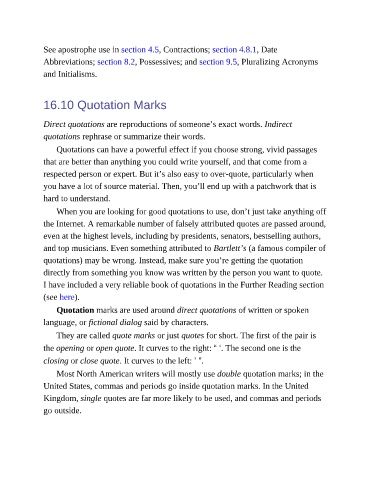Page 167 - Perfect English Grammar: The Indispensable Guide to Excellent Writing and Speaking
P. 167
See apostrophe use in section 4.5, Contractions; section 4.8.1, Date
Abbreviations; section 8.2, Possessives; and section 9.5, Pluralizing Acronyms
and Initialisms.
16.10 Quotation Marks
Direct quotations are reproductions of someone’s exact words. Indirect
quotations rephrase or summarize their words.
Quotations can have a powerful effect if you choose strong, vivid passages
that are better than anything you could write yourself, and that come from a
respected person or expert. But it’s also easy to over-quote, particularly when
you have a lot of source material. Then, you’ll end up with a patchwork that is
hard to understand.
When you are looking for good quotations to use, don’t just take anything off
the Internet. A remarkable number of falsely attributed quotes are passed around,
even at the highest levels, including by presidents, senators, bestselling authors,
and top musicians. Even something attributed to Bartlett’s (a famous compiler of
quotations) may be wrong. Instead, make sure you’re getting the quotation
directly from something you know was written by the person you want to quote.
I have included a very reliable book of quotations in the Further Reading section
(see here).
Quotation marks are used around direct quotations of written or spoken
language, or fictional dialog said by characters.
They are called quote marks or just quotes for short. The first of the pair is
the opening or open quote. It curves to the right: “ ‘. The second one is the
closing or close quote. It curves to the left: ’ ”.
Most North American writers will mostly use double quotation marks; in the
United States, commas and periods go inside quotation marks. In the United
Kingdom, single quotes are far more likely to be used, and commas and periods
go outside.

